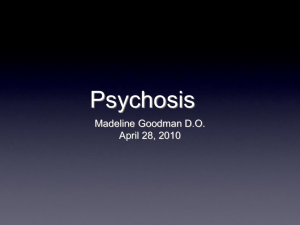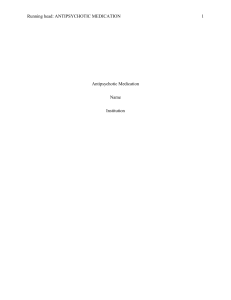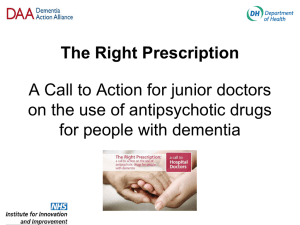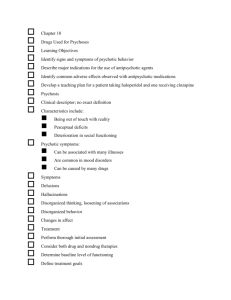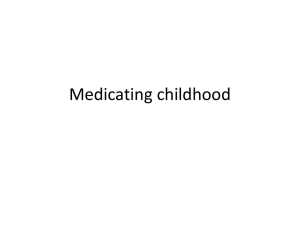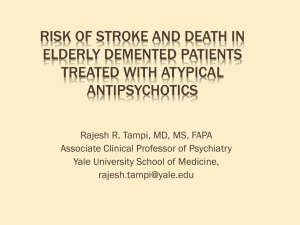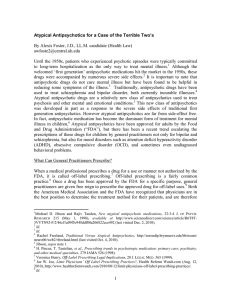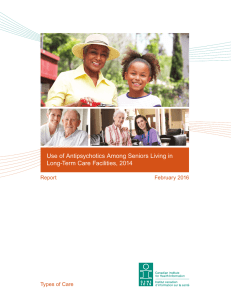Non Pharmalogical Approaches Dr Wanda Spurlock
advertisement
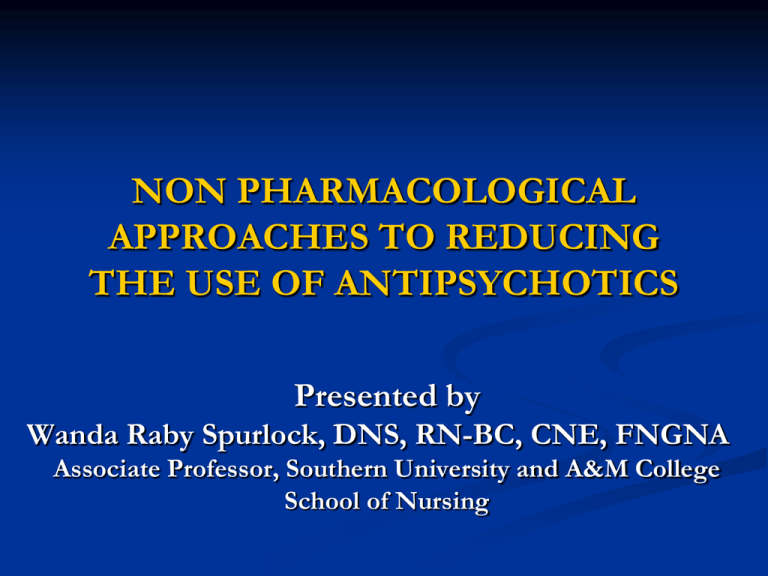
NON PHARMACOLOGICAL APPROACHES TO REDUCING THE USE OF ANTIPSYCHOTICS Presented by Wanda Raby Spurlock, DNS, RN-BC, CNE, FNGNA Associate Professor, Southern University and A&M College School of Nursing PSYCHOSIS: KEY POINTS Hallucinations Perceptions without stimuli Can occur in any sensory modality Delusions Fixed or false perceptions or beliefs not in keeping with reality Unfounded ideas that can be suspicious (paranoid), grandiose, somatic, selfblaming, etc. Not the result of religious or cultural norms Psychosis in the Elderly Commonly used to describe a severe mental illness in which delusions and hallucinations are prominent Can be seen in a wide range of conditions Psychotic symptoms of acute onset are usually the result of a delirium secondary to a medical condition, drug misuse, and drug-induced psychosis Increased Risk of Psychosis in Elderly Persons: Contributing Factors Age related deterioration of frontal and temporal cortices Social isolation Sensory deficits Age related pharmacokinetic and pharmacodynamic changes Polypharmacy Parkinson’s Disease and Hallucinations Anti-Parkinson medications improve motor disorder but may also induce psychotic symptoms, namely visual hallucinations Examples of Medical Conditions that May Cause Psychotic Symptoms Cerebrovascular disease CNS trauma Fluid or electrolyte imbalance Hepatic disease Hypo-hyperthyroidism Neoplasms Metabolic conditions Hypoxia, hypoglycemia Normal pressure hydrocephalus Vitamin deficiency (B12) Huntington’s disease Four Common Types of Misidentifying Delusion in Persons with Alzheimer’s #1 The Capgras Type False belief that previously known people (e.g. wife or caregiver) have been replaced by imposters Spouse or caregiver is an imposter Four Common Types of Misidentifying Delusion in Persons with Alzheimer’s #2 Phantom Boarder Symptom False belief that guests are living in the person’s house Four Common Types of Misidentifying Delusion in Persons with Alzheimer’s #3 The Mirror Sign Person misidentifies his or her own mirror image as someone else Four Common Types of Misidentifying Delusion in Persons with Alzheimer’s #4 The TV Sign Misidentification of TV images as real Points to Remember Hallucinations and delusions that do not cause distress do not require pharmacological intervention Correcting auditory and visual deficits may improve symptoms Late-onset schizophrenia is a rare disorder Paradigm Shift in Dementia Care Biomedical Model Defined in terms of pathological changes Inevitable decline; incurable Progressive cognitive and functional decline Person-Centered Care Centered around deficits expectation of loss of competency As communication and cognitive functioning are affected by the disease progression, care is aimed at meeting basic biologic needs Knowledge of individual’s personal history, life-long patterns, standing personality traits, and coping patterns Aimed to maximize existing strengths Abilities oriented care – retained abilities; prevention of excess disability Modification of environment to support and enhance safety Adaptation of environment to meet changing needs Social engagement Personal preferences, likes, dislikes The Progressively Lowered Stress Threshold (PLST) Model Major premises: internal and environmental stressors beyond a person’s threshold for coping lead to increased disability Examples: fatigue; adverse effects of medications; noise; pain; multiple competing stimuli environmental modifications will reduce environmental stressors and prevent or lessen behavioral symptoms (Smith, Gerdner, Hall, & Buckwalter, 2004) Needs Driven Dementia Compromised Behavior Provides a different way of viewing behaviors Examines source of behaviors Expression of unmet needs Unmet needs manifest in behavioral symptoms Key is to identify root cause of behavior All behavior is meaningful Triggers Focus on treating, reducing, eliminating or modifying factors that cause or contribute to behaviors (Algase et al., 1996) Behavioral Triggers Environmental Poor lighting with shadowing effect, glare Excessive noise Clutter Uncomfortable temperatures Psychological Anger Fear Loneliness Boredom Frustration Physical • • • • • • Hunger Pain Thirst Constipation Fatigue Infection Communication Validation vs Reality Orientation Don’t argue with, attempt to convince or force person to accept reality Use a matter of fact approach More effective to address the person’s feelings in relation to what they perceive as reality Responding to the emotional content of what the person is saying, rather than presenting “factual reality” is more beneficial and less likely to result in increased agitation or a catastrophic reaction. Prior to Using Antipsychotic Drugs: Checklist Rule out medication side effect Underlying medical condition Social and physical environment sensory overload sensory deprivation Result of unmet need Life-long personality traits Use of non-pharmacological interventions as front-line approach Dopamine Antipsychotics and Dopamine Parkinson’s Disease and Dopamine Target Symptoms Target symptoms should be clearly identified prior to antipsychotic treatment and carefully monitored over the course of treatment Medication intervention for poorly defined eccentricities provide limited clinical benefit and unnecessary exposure to medication risks and poor health outcomes Antipsychotic Drugs and Inappropriate Treatment Targets Unsociability Poor self-care Restlessness Impaired memory Inattention or indifference to surroundings Wandering Uncooperativeness https://www.healthcare.uiowa.edu/IGEC/IAAdapt/document/Antipsychotic_Prescribing_Guide_Bot h.pdf Antipsychotic Drugs and Inappropriate Treatment Targets Mild anxiety Verbal expression or behaviors not representing a danger or threat to others Nervousness Fidgeting https://www.healthcare.uiowa.edu/IGEC/IAAdapt/document/Antipsychotic_Prescribing_Guide_Both.pdf Atypical Antipsychotics and FDA Black Box Warnings In 2005 the FDA issued a black-box warning of increased risk of death associated with use of atypical antipsychotics in the elderly population with dementia Example of a Boxed Warning “Increased Mortality in Elderly Patients with Dementia-Related Psychosis – Elderly patients with dementia-related psychosis treated with atypical antipsychotic drugs are at an increased risk of death compared to placebo. Analysis of seventeen placebo-controlled trials (modal duration of 10 weeks) in these patients revealed a risk of death in the drug-treated patients of between 1.6 to 1.7 times that seen in placebo –treated patients. Over the course of a typical 10week controlled trial, the rate of death in drug-treated patients was about 4.5% compared to a rate of 2.6% in the placebo group. Although the causes of death were varied, most of the deaths appeared to be either cardiovascular (e.g., heart failure, sudden death) or infections (e.g., pneumonia) in nature. [this drug] is not approved for the treatment of patients with dementia related psychosis. “ (p. 4) Levinson, D. (2011). Medicare atypical antipsychotic drug claims for elderly nursing home residents. Department of Health and Human Services. Office of the Inspector General. OEI-07—8-00150 Black Box Warning Extended to Conventional Antipsychotics The FDA extended the black box warning to conventional antipsychotic drugs in 2008 Elderly persons with dementia-related psychosis treated with antipsychotic drugs (conventional or atypical) are at ↑risk of death Neither class of drugs is FDA approved for use in treatment of dementia related psychosis Office of Inspector General (OIG) May 2011 Report Evaluation requested regarding use of atypical antipsychotics in elderly NH residents Atypicals approved by FDA for use in treatment of schizophrenia and/or bipolar disorder Concern regarding use for off-label conditions (i.e., conditions other than schizophrenia and/or bipolar disorders) and/or for residents with the condition specified in the FDA boxed warning (i.e., dementia). Side effect of atypical drugs include increased risk of death in elderly persons with dementia Levinson, D. (2011). Medicare atypical antipsychotic drug claims for elderly nursing home residents. Department of Health and Human Services. Office of the Inspector General. OEI-07—8-00150 Other Adverse Side Effects Cardiovascular Hypotension Orthostatic hypotension Cardiac arrhythmias Central Nervous System Sedation Reduction in seizure threshold prolongation of QT interval Endocrine Gastrointestinal • Weight gain • Diabetes mellitus Liver • Nausea • Diarrhea • Constipation • Cholestatic jaundice • ↑transaminase enzyme activities Potential Antipsychotic Drugs Side Effects Extrapyramidal Akathisia Drug induced Parkinsonism Dystonia Acute dystonic reaction Tardive dyskinesia Anticholinergic Dry mouth, blurred vision Glaucoma Constipation Urinary hesitancy/retention Impairment in cognitive functioning and hallucinations Extrapyramidal Side Effects (EPSEs) Side Effect Nursing Considerations Akathisia • Most often with high potency antipsychotics • Hallmark symptoms: inability to sit still, pacing, squirming • Critical to distinguish between ↑ anxiety or psychotic agitation Drug induced Parkinsonism • 3 major hallmark symptoms: tremors, rigidity, and bradykinesia • Mental effects: bradyphrenia and cognitive impairment • ↑ susceptibility to aspiration or to injury due to falls Acute Dystonias • Early recognition of hallmark symptoms: tightening of jaw, stiff neck, swollen tongue • Later signs: Severe and bizarre muscle contractions i.e. oculogyric crisis , torticollis, opisthotonos, glossopharyngeal constrictions • Painful and very frightening • Accurate observation promotes prompt recognition and treatment Example of objective EPSE assessment tool: The Abnormal Involuntary Movement Scale (AIMS) Sensory Enhancement Measures Examples Landscaped outdoor gardens Soothing environmental sounds such as singing birds, waterfall, soft music Pleasing odors that stimulate the senses (baking smells, fresh brewed coffee, tea, fresh flowers) Provide for periods of exposure to natural lighting when possible Incorporate items in environment that stimulate the 5 senses: visual (memory books and scrap books containing family pictures, different textures such as cotton balls, perfumes, citrus odors from fruits such as lemons and oranges, smells from plants such as lavender, and roses) Measures to Prevent Sensory Overload Examples Decrease environmental stimuli ( noise generated from equipment, TVs, stereos and background noise from loud conversations Keep use of overhead paging at a minimum Avoid use of large mirrors Use appropriate level of lighting to prevent casting of shadows in environment Comfortable room temperature Assess for unmet physical needs such as toileting, hunger, thirst, pain, constipation Utilize therapeutic communication strategies to prevent catastrophic reactions Maintain a calm, non-hurried approach to care Allow for periods of rest between challenging activities Resistance to Care During Bathing Nursing Approaches Person-Centered Care Approaches Communication Strategies Environmental Modifications • Requires knowledge of lifelong bathing preferences, individual rituals surrounding bathing, and awareness of cultural considerations • “See” through the eyes of the person with dementia • Focus is on “individual” not the task being performed • Avoid hurried movements • Allow participation in care to the degree possible • Calming voice • Simple, step by step, directions and instructions • Avoid use of “elderspeak” • Engage in “pleasant” conversations on topics of interest • Verbal cueing, sequencing, gesturing, priming, or mirroring • Never scold; Offer praise and unconditional regard • ↓ extraneous noise • Soft, relaxing, preferred music • Avoid bright lights, glare or shadows • Maintain comfortable room and water temperature • Remove clutter and items that could be distracting or frightening Examples of Stage Related Symptoms and Non-Pharmacological Interventions Stage Mild Symptoms Forgetfulness Generalized anxiety Restlessness, pacing Isolation or withdrawal from usual activities Apathy Depression Interventions Memory books Reminiscence therapy Meaningful structured activity/ exercise Indoor/outdoor gardening Music therapy (individual preferred) *Note: Interventions from either stage can be used based on individualized needs/response Examples of Stage Related Symptoms and Non-Pharmacological Interventions Stage Moderate Symptoms Shadowing ↑ restlessness and pacing Wandering Physical aggression; agitation Sundowning More severe diurnal or circadian rhythm disruptions Suspiciousness, accusatory paranoia Delusions, hallucinations Interventions* Simulated presence therapy Individualized, preferred music; soothing music Validation therapy White noise Pet therapy Aromatherapy, message therapy Video-respite *Note: Interventions from either stage can be used as appropriate based on individualized needs/response Examples of Stage Related Symptoms and Non-Pharmacological Interventions Stage Severe Symptoms Repetitive vocalizations Screaming, yelling, crying out, moaning Interventions* Soft, calming music Snoezelen® (multisensory) Simulated presence therapy *Note: Interventions from either stage can be used based on individualized needs/response Benefits of Sleep Brain tissue restoration Body restoration Energy conservation Memory reinforcement Regulation of immune function Metabolism and regulation of certain hormones Thermoregulation A Single Normal Sleep Pattern Non Drug Measures to Promote Sleep Warm milk, soothing, preferred music, aromatherapy, light message Eliminate intake of caffeine in late afternoon and evening, offer opportunity for toileting prior to retiring for sleep Encourage periods of interaction between family and staff during daytime Engage in meaningful individual and/or group activities Reduce levels of environmental stimuli (i.e. sounds and images from TVs kept playing in room during evening and nighttime hours) Proper lighting in room to avoid shadowing effect REMEMBER: A “Person”-Centered Approach Builds on Individual Strengths and Abilities to Maximize and Promote Independence Honors importance of keeping the “Person” at the center of care planning and decision making Promotes choice, purpose and meaning in daily life of the “Person” “Person” supported in achieving a maximal level of physical, mental and psychosocial well-being Premium placed on active listening to and observing the “Person” The End
